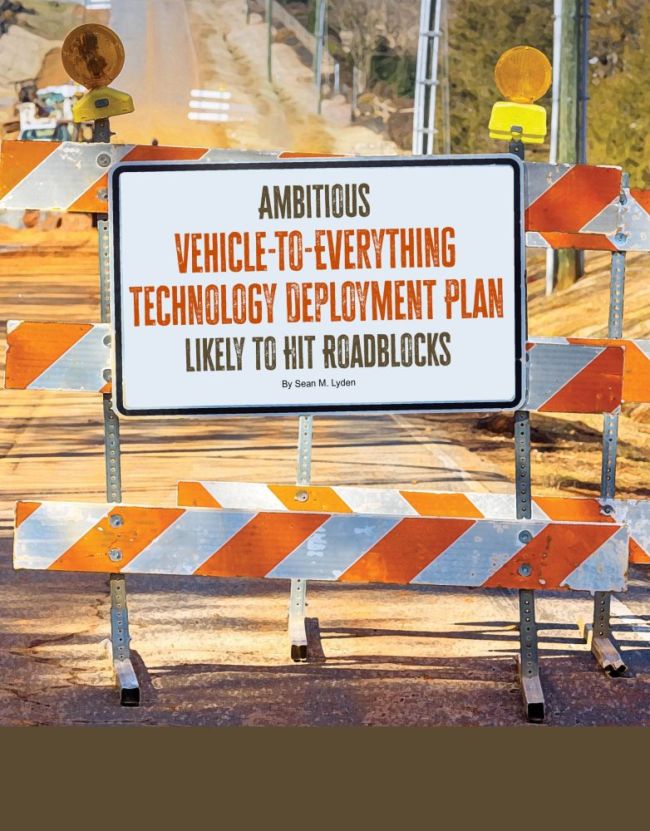
Ambitious Vehicle-to-Everything Technology Deployment Plan Likely to Hit Roadblocks
Imagine this scenario: A utility crew heads out to repair a downed power line. As they arrive at the site, the truck’s vehicle-to-everything (V2X) system automatically transmits specific details about the work zone perimeter, the presence of crew members, and even the location of extended bucket trucks and other equipment. Vehicles approaching the area receive automated alerts, potentially triggering automatic speed reductions or lane-change suggestions well before visual contact is made.
The V2X technology also interfaces with existing traffic management systems, as nearby traffic signals automatically adjust timing to facilitate safer traffic flow around utility work zones. Digital road signs automatically display warning messages, and navigation apps in connected vehicles suggest alternate routes, reducing traffic volume near utility crews.
This is just a glimpse into the possibilities for utility fleets should the U.S. Department of Transportation’s ambitious plan announced in August become a reality.
The initiative, detailed in “Saving Lives with Connectivity: A Plan to Accelerate V2X Deployment” (see www.its.dot.gov/research_areas/emerging_tech/pdf/Accelerate_V2X_Deployment_final.pdf), aims to eliminate traffic deaths through the widespread adoption of V2X technology by 2036.
The DOT plan sets three major milestones. By 2028, V2X technology should cover 20% of the National Highway System and a quarter of traffic signals in major metropolitan areas. By 2031, coverage expands to half of the highway system. The final phase targets nationwide deployment by 2036, including V2X capability in 20 vehicle models and 75% of the nation’s intersections.
“The only acceptable number of roadway deaths is zero,” DOT officials stated in the report.
But despite the plan’s admirable goals, it carries no regulatory mandates or dedicated federal funding, which makes a successful large-scale V2X rollout in the U.S. a long shot, especially considering the following six challenges.
1. How will state and local agencies fund the massive infrastructure deployment needed without dedicated federal funding?
The DOT’s plan sets an ambitious target of equipping 75% of the nation’s intersections with V2X technology by 2036 but leaves a critical question unanswered: Who’s paying for it? Without federal funding, state and local agencies are being asked to undertake one of U.S. history’s largest infrastructure modernization efforts using existing budgets and funding mechanisms. Even larger cities with robust tax bases would struggle to fund such extensive upgrades while maintaining existing infrastructure and services.
2. Without regulatory mandates, what will motivate OEMs to invest in V2X technology at the scale needed?
The DOT’s plan presents a classic “chicken-and-egg” dilemma for automotive manufacturers. Without regulatory requirements, automakers face a complex business decision: invest heavily in V2X technology for vehicles that may not have infrastructure to communicate with, or wait for infrastructure that may not be built without vehicles to use it.
The plan’s target of 20 V2X-capable vehicle models by 2036 represents a significant investment from OEMs. Each manufacturer must justify the costs of developing, testing and implementing V2X systems across their vehicle lines – all without a regulatory mandate requiring them to do so.
3. How will the system protect personal information while still allowing the data-sharing necessary for V2X operation?
The large-scale V2X deployment presents a fundamental tension: The system needs enough information about vehicles, pedestrians and their movements to prevent accidents. But it also must protect individual privacy in an era of increasing data surveillance concerns.
The DOT’s plan requires vehicles and devices to constantly broadcast their location, speed and trajectory – data that, when combined, could create detailed maps of individual movements and behaviors. This isn’t just about tracking vehicles; modern V2X systems might know when you walk across an intersection, your typical route to work or your daily schedule based on regular movements. The plan states that personally identifiable information should be “the minimum necessary” and kept for “the shortest time practical,” but defining these boundaries in practice becomes increasingly complex at scale.
4. How will agencies with limited expertise and institutional capacity manage complex V2X deployments?
Managing V2X technology demands a fundamental transformation of traditional transportation departments into sophisticated technology organizations – a shift many agencies are likely unprepared to make. While the DOT’s plan offers technical assistance and training resources, it underestimates the massive institutional evolution required for thousands of transportation agencies to deploy and maintain complex connected vehicle systems.
5. How will deployment be coordinated across thousands of jurisdictions?
The U.S. transportation system is a patchwork of roughly 50,000 independent jurisdictions, each with its own priorities, budgets and decision-making processes. But the DOT’s plan envisions vehicles seamlessly communicating as they cross city, county and state lines – a vision that requires a level of interjurisdictional coordination unprecedented in U.S. transportation history.
Think about it: Software updates, security protocols and data-sharing agreements must somehow be harmonized across thousands of independent entities, each with its own legal requirements and operational constraints. That level of collaboration and coordination is asking a lot, especially with cash-strapped municipalities.
6. Without regulatory mandates, how will the DOT ensure all stakeholders move in the same direction at the pace needed to achieve the plan’s ambitious timeline?
The DOT’s V2X plan presents a striking paradox: It sets highly specific national deployment targets while explicitly stating it has no regulatory authority to require anyone to meet them. This voluntary approach to transforming the nation’s transportation infrastructure is like trying to coordinate a massive symphony orchestra without a conductor – and where the musicians aren’t required to show up.
The plan’s timeline requires synchronized action from automakers, state transportation departments, local governments, technology vendors and telecommunications providers. Each stakeholder must make significant investments and organizational changes based largely on faith that others will do the same. Without regulatory requirements, each entity can freely choose when and how to participate – or whether to participate at all.
The Bottom Line
V2X technology offers compelling potential for significantly driving down road fatalities in the U.S. But does the DOT’s plan chart the right course for turning that potential into a realistic possibility? That’s difficult to see under the current market and regulatory conditions.

